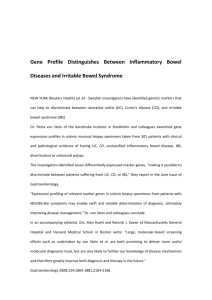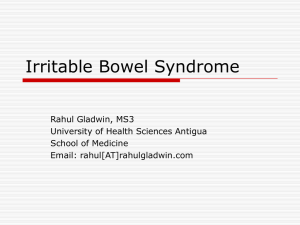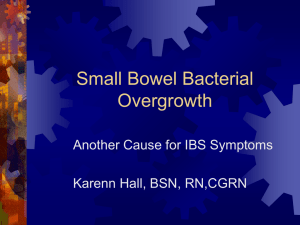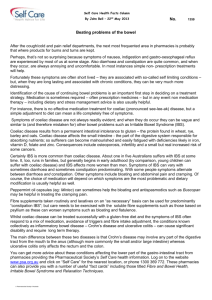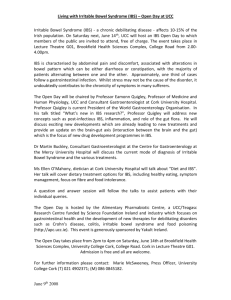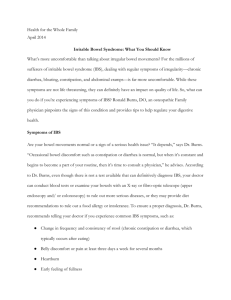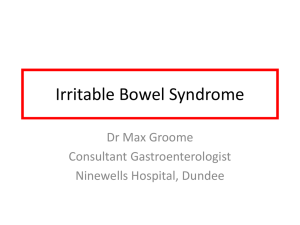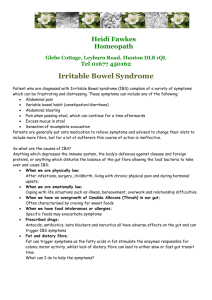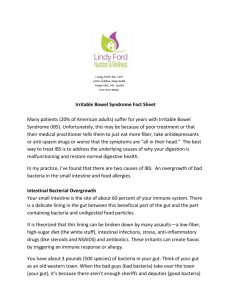Gastroenterology for GP's
advertisement
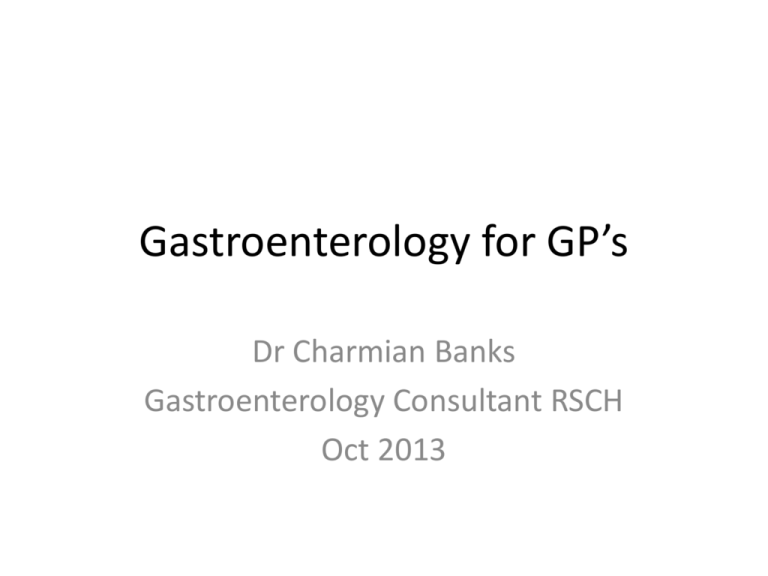
Gastroenterology for GP’s Dr Charmian Banks Gastroenterology Consultant RSCH Oct 2013 Outline of Talk • • • • • • • • Diarrhoea When to refer Faecal calprotectin Diarrhoea predominant IBS FODMAP’s Constipation predominant IBS Treatment options available Case studies Diarrhoea • WHO Definition: Having three or more liquid stools per day (type 5-7 on Bristol Stool chart). • Or having more stools than is necessary for that person. Types of diarrhoea • • • • • Secretory Osmotic Exudative Motility related Inflammatory Secretory Diarrhoea • An increase in active secretion or inhibition of absorption. • E.g. Cholera toxin, which stimulates secretion of anions such as Cl- and to maintain a charge balance in the lumen, sodium and water are carried along with it. • Diarrhoea continue even when there is no oral intake. Osmotic diarrhoea • Occurs when too much water drawn into the bowels. • E.g. Lactose/fructose intolerance, maldigestion (where nutrients are left in the lumen to pull in water, CD/pancreatic disease. • Osmotic laxatives Exudative Diarrhoea • With blood and pus in the stool • E.g. Inflammatory bowel disease, sever infections such as E.Coli Motility-related • Hypermotility or rapid transit through the bowels • E.g. Post vagotomy, diabetic neuropathy, short bowel, hyperthyroidism Inflammatory Diarrhoea • Damage to the mucosal lining leading to passive loss of protein rich fluids. • Causes include bacterial or viral infections, parasitic infections, IBD, microscopic colitis, TB, colon cancer and enteritis. Causes of Diarrhoea • • • • • • • • • • • • Infectious Malabsorption Inflammatory/microscopic Malignancy Irritable bowel syndrome Ischaemic Small bowel bacterial overgrowth Bile-salt malabsorption Short bowel syndrome Hormone-secreting tumours Medication-related Laxative abuse Investigations • Good history e.g. travel, acute/chronic onset, family history, social • Examination including PR for all with tenesmus or blood PR • Bloods including FBC/U&E’s/LFT’s/CRP/TSH/Calcium/TTG • Stool sample for MC&S (consider C diff, OCP, micro/cryptosporidium depending on history) • Faecal Calprotectin? Alarm features Alarm features from NICE and BSG guidelines.1,2 Faecal Calprotectin • Calprotectin is a major protein found in the cytosol of inflammatory cells. • It is stable in stool samples for up to seven days • Since 2000 it has been evaluated in numerous diagnostic studies. • Meta-analysis in BMJ 2010 evaluated whether adding faecal calprotectin testing to the investigation of patients with suspected inflammatory bowel disease reduced the number of unnecessary endoscopies. • Studies showed that adding calprotectin to the screening pathway can lead to delays in diagnosis • There has been debate in the values used as the cut-off points • The level of calprotectin does not always correlate with degree of inflammation • A third of patients with suspected inflammatory bowel disease will have a negative colonoscopy increasing to half if there is no pr bleeding. • However, an increase in faecal calprotectin levels identifies patients who are most likely to have inflammatory bowel disease and then justifies an urgent colonoscopy. • Use of faecal calprotectin as a screening test reduces the number of endoscopies with negative results in both adults and children with suspected inflammatory bowel disease. Irritable Bowel Syndrome • Rome III diagnostic criteria for irritable bowel syndrome: – At least 3 months, with onset at least 6 months previously of recurrent abdominal pain or discomfort associated with 2 or more of the following Improvement with defecation Onset associated with a change in frequency of stool Onset associated with a change in form of stool NICE criteria for IBS • Abdo pain relieved by defecation or associated with altered stool frequency/form, plus 2 or more of – Altered stool passage – Abdominal bloating/distention – Symptoms made worse by eating – Passage of mucus Sub-typing of IBS • Based on stool consistency alone – IBS with constipation (IBS-C) – IBS with diarrhoea (IBS-D) – IBS mixed type (IBS-M) – IBS unsubtyped (IBS-U) Diagnosing IBS • Abdominal pain or discomfort • Bloating • Change in bowel habit When to refer- red flags in the history • • • • Unintentional/ unexplained weight loss Rectal bleeding Fhx CRC/ovarian cancer Looser/more frequent stools persisting for more than 6 weeks in a person aged over 60 When to refer- red flags clinically • • • • Anaemia Abdominal masses Rectal masses Raised inflammatory markers Proposed mechanisms of IBS • • • • • • • • Genetics Parental influence Disturbance of GI motility Increased colonic motility Visceral hypersensitivity Altered pain processing Stress response Post-infective Management • Dietary and lifestyle advice – Identify and make the most of their available leisure time and to create relaxation time – Encourage an increase in their activity levels – Diet: regular meals, avoid missing meals, 8 cups of fluid per day, restrict tea and coffee, reduce alcohol and fizzy drinks, limit high-fibre foods, limit fresh fruit to 3 portions a day, avoid processed or recooked foods, avoid sorbitol, encourage people with bloating to eat oats and linseeds (NICE 2008). – Low FODMAP diet Pharmacological therapy • Antispasmodics • Laxatives- avoid lactulose • Loperamide (liquid preparation allows finer adjustment to prevent constipation) • Colpermin • Tricyclic anti-depressants as second-line treatment, start at 10mg ON and increase to max 30mg ON. (S/E constipation) • SSRI’s – S/E diarrhoea Psychological interventions • CBT • Hypnotherapy • Psychological therapy (psychodynamic interpersonal therapy) • No evidence to support acupuncture or reflexology in IBS – Consider in patients who do not respond to pharmacological treatments after 12 months i.e. those with refractory IBS. FODMAPs • Rapidly fermentable short-chain carbohydrates • Fermentable Oligo-, Di-, Mono- saccharides And Polyols. • 3 common functional properties – Poorly absorbed in the small intestine – Small and osmotically active – Rapidly fermented by bacteria • 2 key components to the FODMAP concept – Dietary approach restricts FODMAP’s globally not individually – FODMAP’s do not cause the underlying functional disease but represents an opportunity for reducing symptoms Shepherd and Gibson 2006 • Retrospective study of 64 IBS patients on low FODMAP diet • 77% adhered • ¾ had marked improvement of all IBS abdominal symptoms Fructose malabsorption and symptoms of irritable bowel syndrome: guidelines for effective dietary management. J Am Diet Assoc 106:1631-1639 Staudacher 2010 • UK service evaluation assessed response to the low FODMAP diet compared to those given the NICE guideline advice • Dieticians completed questionnaires for each IBS review patient seen • Symptom and satisfaction questions • Total n=82 (n=39 standard; low FODMAP n=43) Results- Symptom change Symptom Standard Low FODMAP P value Bloating 17/39 32/39 0.002 Abdo pain 20/33 29/34 0.02 Diarrhoea 18/29 30/36 0.052 Flatulence 14/28 33/38 0.001 Constipation 10/22 14/21 0.2 Nausea 4/14 10/15 0.04 Poor energy 11/30 10/15 0.04 Composite score 19/39 37/43 <0.001 Global satisfaction 20/37 32/42 0.04 Shepherd et al 2008 • 25 IBS patients • Already had symptomatic improvement on low FODMAP diet • Challenges with fructose and fructans induced symptoms • Therefore improvement not placebo or due to change in other dietary components e.g. gluten. Dietary triggers of abdominal symptoms in patients with irritable bowel syndrome: randomised placebo-controlled evidence. Clin Gastroenterol and Hepatol 6:765-771 De Roest et al 2013 • Prospective study • 90 patients with a mean follow up of 15.7 months who had performed breath testing for fructose and lactose malabsorption and had received dietary advice for low FODMAP diet • Abdo pain, flatulence, bloating and diarrhoea significantly improved (p<0.001 for all) • Fructose malabsorption significantly associated with symptom improvement. • 75.6% adherent to the diet which was associated with symptom improvement. • 72% satisfied with their symptoms The low FODMAP diet improves gastrointestinal symptoms in patients with irritable bowel syndrome: a prospective study. Int J Clin Pract 2013 Sep;67(9):895-903 Constipation-predominant IBS • • • • • • Lifestyle advice Linseeds Anti-spasmodics Laxatives TCA’s or SSRI’s Psychological interventions Linaclutide • Only treatment licensed specifically for IBS-C • Licensed for the symptomatic treatment of moderate to severe IBS-C • Novel targeted therapy, dual mode of action taken once a day • Targets abdominal pain, bloating and constipation and acts locally in the GI tract • 2 randomised double blind placebo controlled trials in 1602 patients • 26 week treatment or 12 week treatment • Both trials showed significant and early reduction of abdo pain p<0.0001 • Significant and sustained decrease in bloating p<0.0001 • Significant improved stool frequency, consistency and straining p,0.0001 • Well tolerated as minimally absorbed, diarrhoea main side effect, no differences in serious adverse events between linaclutide and placebo • A bit more expensive than prucalopride? Cases Case study: Kate Kate W* is 36 and works as a personal assistant in a busy office. Over the past 12 months, she has consulted five other GPs in your practice for symptoms of anxiety, headache, abdominal pain, and constipation. *All patient names are fictional Case study: Kate You have heard your colleagues in the staff room discussing how Kate keeps returning with non-specific symptoms and never seems satisfied with the various treatments given. She has booked a consultation with you later today. GI routemap UKLIN1693, date of preparation: March 2013. Case study: Kate When you see Kate, she explains that she has abdominal discomfort and frequent bloating. She does not pass stools very frequently and usually finds that she has to strain. She describes her stools as ‘hard,’ and finds that her symptoms are relieved by having a ‘good’ bowel movement. Case study: Kate When asked how long she has been having symptoms, Kate explains that she has had them intermittently for 10 years, but has never received a satisfactory diagnosis or management plan. What is your gut feeling about her diagnosis? An important part of GI diagnosis is eliminating organic disease Need to eliminate the possibility of organic disease:1 • Check for alarm features2,3 Case study: Kate • Questioning reveals that Kate does not have any alarm features. From her notes, you can see that the results of previous investigations have been unremarkable, and therefore her history does not indicate cause for concern. Case study: Kate • You can be fairly confident of a functional diagnosis for Kate. Agreeing an IBS diagnosis Agreeing an IBS diagnosis: ideas • You’ve had these symptoms for a while now, what’s been going through your mind? • What thoughts have you already had about this? • What is your perception of what’s happening? Agreeing an IBS diagnosis: ideas • You’ve had these symptoms for a while now, what’s been going through your mind? • What thoughts have you already had about this? • What is your perception of what’s happening? Agreeing an IBS diagnosis: concerns • Is there anything that you are particularly worried this might be? • I’m wondering what your partner thinks… • Some patients find that… • Have you changed any aspects of your life because of your symptoms? Case study: Kate With prompting, you discover that Kate is still concerned that her symptoms are due to something more serious than IBS. How can you explain that you are sure her symptoms are caused by IBS? The bowel is a muscular tube – The bowel is a muscular tube that squeezes content from one end to the other – In IBS-D, muscular contractions may be stronger and more frequent than normal. In IBS-C, contractions may be reduced Gut response to triggers may be altered in IBS • Contractions can be triggered by waking and eating • In IBS-D, the response to these normal triggers may be stronger than normal. In IBS-C, the response may be reduced IBS pain does not indicate disease • The pain associated with IBS is like cramp; it hurts, but does not indicate disease The stress response may be chronic in IBS • We all get butterflies and diarrhoea in response to stress • In IBS, the gut is more sensitive to stress, and this response can become chronic The brain hears the gut too loudly in IBS • The brain is able to hear messages from the gut such as hunger or the urge to go to the toilet • In IBS the brain hears these messages too loudly Heightened gut awareness • The gut works all day, every day, but most people do not feel it • People with IBS often have an excessive awareness of normal digestive processes IBS requires long-term management IBS patients tend to have a long-term consultation pattern.1 • Initial consultation Provide positive diagnosis • Subsequent consultations Formulate management plan IBS diagnosis: key points Patients who present with IBS are often female, in their 30s/40s, have stress comorbidity, and a pattern of repeated consultations. The main symptoms of IBS are abdominal pain, bloating, and change in bowel habit. Symptoms tend to be relapsing and remitting and relieved by defaecation. IBS diagnosis: key points Abnormal patterns of endogenous pain modulation have been seen in IBS patients. Irritable bowel syndrome can be associated with constipation. The three subtypes of IBS are IBS with constipation, IBS with diarrhoea, and mixed IBS. IBS diagnosis: key points IBS can be positively diagnosed using symptoms, alarm features, and minimal investigations. Defining patients’ ideas and concerns and using explanatory models can help patients to accept a diagnosis of IBS. • Thank-you for listening • Any Questions?
